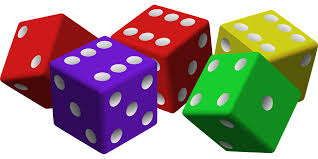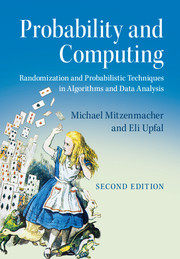CS 5330 - Randomized Algorithms
(Spring 2019)
NUS School of Computing
Prof. Seth Gilbert
Tuesday 6:30pm - 9:30pm
I3-0344


News
| March 8 | Review material for midterm posted. |
| February 21 | Experimental algorithms problem set posted. |
| February 14 | Problem set 4 posted! Project proposal submission link posted here. |
| January 31 | Problem set 3 posted! Problem set 1 solutions posted. |
| January 23 | Problem set 2 posted! |
| January 15 | Problem set 1 posted! |
| January 15 | First class! Welcome to CS5330! |
Course Overview
Description
The module will cover basic concepts in the design and analysis of randomized algorithms. It will cover both basic techniques, such as Chernoff bounds, random walks, and the probabilistic method, and a variety of practical algorithmic applications, such as load balancing, hash functions, and graph/network algorithms. The focus will be on utilizing randomization to develop algorithms that are more efficient and/or simpler than their deterministic counterparts.
Coursework
There will be a variety of assignments due throughout the semester:
- There will be (approximately) weekly problem sets covering the algorithms and techniques described in class.
- Toward the middle of the semester, there will be an experimental evaluation in which you implement and experiment with a family of randomized algorithms.
- There will be one midterm exam.
- Throughout the semester, you will work on a project exploring the power of randomization in a context of interest to you.
Schedule
Below is the tentative schedule for the course. I will modify the schedule as the course progresses. Problem sets will be posted below on this schedule as they become available.
| Class Number | Date | Description |
| Classical Algorithms | ||
| 1 | 15/01 | Introduction and logistics. Karger (and Stein) MinCut. Simple branching processes. |
| 2 | 22/01 | Sorting, Stable Marriage, and More!
|
| 3 | 29/01 | Hashing: Chaining, Linear Probing, and Cuckoo!
|
| 4 | 05/02 | Chinese New Year! |
| Sampling, Markov Chains, and Random Walks. | ||
| 5 | 12/02 | Chernoff Bounds and Sampling
|
| 6 | 19/02 | Chernoff Bounds and Sampling (Part 2)
|
| Break | 26/02 | No class: Mid-semester break |
| 7 | 5/3 | Random Walks (Part 1) |
| 8 | 12/3 | Midterm Exam |
| 9 | 19/3 | Random Walks (Part 2)
|
| 10 | 26/3 | Random Walks (Part 3)
|
| Advanced Topics | ||
| 11 | 2/4 | Expert Learning |
| 12 | 9/4 | Probabilistic Method |
| 13 | 16/4 | Project Presentations |
| End of class |
Course Logistics
Office Hours
For now, office hours are by appointment. Once the semester begins, I'll schedule regular weekly office hours (and update the website here).
Contact
To ask me small logistical questions, I prefer that you grab my attention immediately before or after class. For substantive content questions, schedule a meeting with me.
Book
This class will be loosely based on material from the book Probability and Computing by Mitzenmacher and Upfal.
Problem Sets
There will be weekly problem sets throughout the class. These problems sets will focus on algorithm questions: solving problems, devising algorithms, proving theorems. There will be one assignment that focuses on a larger experimental evaluation of a collection of randomized algorithms.
Problems will be graded on a simplistic 0/1/2 scale: a 0 indicates minimal understanding (or a problem not completed); a 1 indicates some understanding but many mistakes or poor presentation; 2 indicates a mostly correct answer. (Bonus points may be awarded for particularly nice solutions and/or for optional problems.)
The following rules will help keep the problem set submission and grading process running smoothly:
- You must hand in a solution that is unique, consisting of your work alone. You may discuss high-level strategy with other students in the class. You may read the textbook, or other reference pages on general topics. However, the solution you hand in must be written by you alone, and any similarities to any other student's submission (or to any web page or solution on the web) will be considered cheating. It will be considered equally cheating whether you copy from someone else, or if someone else copies from you.
Do not compare or share your solution with others.
- You may not read or use solutions found on the web for identical problems, whether from prior years of this class or from other classes elsewhere.
- You may talk to people about general strategies, and you may use reference material available on the web (e.g., Wikipedia, lecture notes from other classes, etc.). If you talk to anyone else or read any reference material, you may not take notes on your discussion. Afterwards, spend half an hour on facebook (or some equivalent activity), before working further on the problem set.
- You are encouraged to typeset your problem sets (and are especially encouraged to use Latex). However, you may submit your problem sets in any form that is clear and easily legible. You are also encouraged to include many pictures and diagrams and examples in your problem sets. It is perfectly acceptable to typeset the problem set and attach hand-drawn figures.
- Problem sets should be handed in no later than the beginning of class on the day they are due. You may bring a physical copy of the problem set to class to give to me before the lecture begins, or you may submit it electronically on IVLE.
- Problem sets not handed in by the beginning of lecture will be considered late, and 10% of the points deducted. Problem sets not handed until the day after the deadline will have an additional 10% deducted (leave late problem sets in the envelope by my door). Beyond this point, problem sets will not be accepted.
Some advice on problem sets:
- Answers to homework should be written at a level suitable for and to address the instructor. In other words, don't put in long explanation for trivial things.
- You will be graded not only on the correctness and efficiency of your answers, but also on your clarity. Therefore, it pays to make your answers more concise and clearer. Understandability of the solution is as desirable as correctness. Sloppy answers will be at a disadvantage. Learn to make appropriate definitions to make your answers more precise and concise.
- Solutions do not have to be type-set, but they have to be neat and readable. Do not waste your time beautifying your answers. If you want to spend more time, you should spend it on improving its clarity, understandability, and other aspects of its technical content.
- From a previous module, you can find some advice on proofs here.
- From a previous module, you can find a sample of what a good solution looks like here.
Exams
There will be one midterm exam in the course. There is no final exam.
Academic Integrity
I take academic integrity seriously. To repeat the problem set instructions from above: the solutions you submit must be your own unique work. Any cases of cheating will be dealt with harshly: a first offense will result in at least a one letter grade deduction for the module (or potentially a zero for the entire module, depending on the severity). When in doubt, ask me what is allowed.